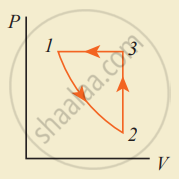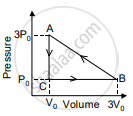Advertisements
Advertisements
प्रश्न
An ideal gas of volume 2 L is adiabatically compressed to (1/10)th of its initial volume. Its initial pressure is 1.01 x 105 Pa, calculate the final pressure. (Given 𝛾 = 1.4)
उत्तर
Given:
Vi = 2 L, Vf = `("V"_"i")/10 ⇒ ("V"_"i")/("V"_"f") = 10, "P"_"i" = 1.01 xx 10^5` Pa, γ = 1.4
To find: Final pressure (pf)
Formula: For adiabatic process: `"p"_"f" "V"_"f"^γ = "p"_"i""V"_"i"^γ`
Calculation:
From formula,
pf = pi × `("V"_"i"/"V"_"f")^γ`
= 1.01 × 105 × (10)1.4
= antilog {log (1.01) + 1.4 × log (10)} × 105
= antilog {0.0043 + (1.4 × 1)} × 105
= antilog {1.4043} × 105
= 2.537 × 106 = 25.37 × 105 Pa
The final pressure (pf) is 25.37 × 105 Pa
संबंधित प्रश्न
Explain why The climate of a harbour town is more temperate than that of a town in a desert at the same latitude.
Heating a gas in a constant volume container is an example of which process?
Draw a p-V diagram of the reversible process.
Draw a p-V diagram of the irreversible process.
Draw a p-V diagram showing negative work with varying pressure.
Explain the cyclic process.
3 mole of a gas at temperature 400 K expands isothermally from an initial volume of 4 litres to a final volume of 8 litres. Find the work done by the gas. (R = 8.31 J mol-1 K-1)
Write a note on free expansion.
Explain work done during a thermodynamic process.
Explain the thermodynamics of the isobaric process.
Explain thermodynamics of the adiabatic process.
The V-T diagram of an ideal gas which goes through a reversible cycle A→B→C→D is shown below. (Processes D→A and B→C are adiabatic)

The corresponding PV diagram for the process is (all figures are schematic)
In an isochoric process, we have ____________.
Give the equation of state for an isothermal process.
Give an equation state for an isochoric process.
Draw the PV diagram for the adiabatic process.
What is meant by a reversible and irreversible processes?
Explain in detail an adiabatic process.
Explain in detail the isochoric process.
In an adiabatic expansion of the air, the volume is increased by 4%, what is the percentage change in pressure? (For air γ = 1.4)
In a petrol engine, (internal combustion engine) air at atmospheric pressure and temperature of 20°C is compressed in the cylinder by the piston to `1/8` of its original volume. Calculate the temperature of the compressed air. (For air γ = 1.4)
Consider the following cyclic process consist of isotherm, isochoric and isobar which is given in the figure.

Draw the same cyclic process qualitatively in the V-T diagram where T is taken along the x-direction and V is taken along the y-direction. Analyze the nature of heat exchange in each process.
An ideal gas is made to go from a state A to stale B in the given two different ways (see figure) (i) an isobaric and then an isochoric process and (ii) an isochoric and then an isobaric process. The work done by gas in the two processes are W1 and W2 respectively. Then,

Two identical samples of a gas are allowed to expand (i) isothermally (ii) adiabatically. Work done is ____________.
An ideal gas A and a real gas B have their volumes increased from V to 2V under isothermal conditions. The increase in internal energy ____________.
An ideal gas is compressed to half its initial volume by means of several processes. Which of the process results in the maximum work done on the gas?
In the figure shown here, the work done in the process ACBA is ______.

In a certain thermodynamical process, the pressure of a gas depends on its volume as kV3. The work done when the temperature changes from 100°C to 300°C will be ______ nR, where n denotes number of moles of a gas.
